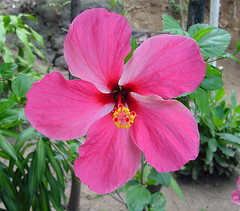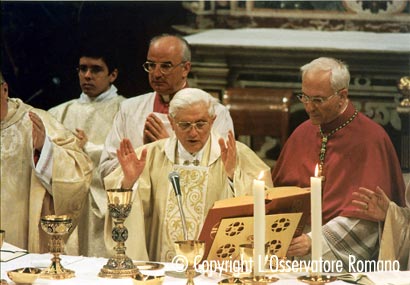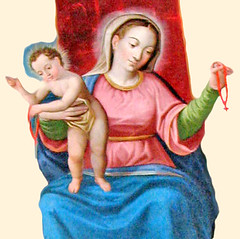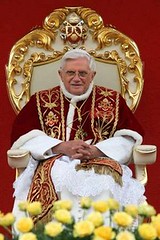Beauty and the Liturgy
prompted me to think again about the role of Beauty in our lives. The theme of Beauty and the inherent beauty of God's revelation is particularly marked in the theological aesthetics of Von Balthasar. In fact, the beauty that is God has an inner splendour that shines forth in what he calls the Herrlichkeit, the subject of his 7 volume 'Glory of the Lord' (GL).
For Balthasar, Beauty "dances as an uncontained splendour around the double constellation of the true and the good and their inseparable relation to one another" (GL1, 18). There is something objective about true beauty. Thus Richard Feynman (a Nobel laureate in physics) can say: "You can recognize truth by its beauty and simplicity". It follows, that God himself is quite simply Beauty.
 However, beauty is not aestheticism and Balthasar is at pains to point this out. Rather, beauty is intrinsic to the form, the very essence (or Being) of a thing. As such, a flower, trees, poetry, a Mozart sonata, a Fra Angelico fresco, all have a form, a pure essence that radiates its truth and goodness - this radiance we call beauty. As Balthasar says: "Both natural forms and the forms of art have an exterior manifestum which appears and an interior depth radiating through the external aspect, neither of which, however, are separable in the form itself" (GL1, 151).
However, beauty is not aestheticism and Balthasar is at pains to point this out. Rather, beauty is intrinsic to the form, the very essence (or Being) of a thing. As such, a flower, trees, poetry, a Mozart sonata, a Fra Angelico fresco, all have a form, a pure essence that radiates its truth and goodness - this radiance we call beauty. As Balthasar says: "Both natural forms and the forms of art have an exterior manifestum which appears and an interior depth radiating through the external aspect, neither of which, however, are separable in the form itself" (GL1, 151).Art is meant to be at the service of Beauty, a contemplation of Beauty, and such art points to truth and goodness. It has always struck me that on a visit to Durham with some non-religious and atheist friends, they were all drawn to the splendid cathedral. I walked with them as they exclaimed in awe of the beauty of the building and were drawn into the building and to spend time within to contemplate Beauty. These same friends of mine are musicians, drawn to classical music, which is yet another manifestation of true Beauty. Somehow, beauty has a power which attracts and sparks a thirst for the divine... if someone can help them link it to God who is Beauty.
I think this is why (until recently) the Liturgy and liturgical arts were marked by Beauty. I don't believe that beauty is about individual taste. In this sense, Beauty is not just in the eye of the beholder; it has an objective quality. For example, I may have a preference for a Roman rite liturgy in Latin with Gregorian chant and polyphony in a Gothic chapel. This may be because I believe these externals radiate a true inner beauty that points to a contemplation of the divine. However, I would not expect to find this in Africa or the Philippines. Instead, I expect to find there, a liturgy that employs indigenous forms but nevertheless true and good form that radiate beauty. Indeed, this was sometimes the case, as in a place like Caleruega in Batangas, the Philippines. Even if my aesthetical taste indicates a preference for one over another, (eg: Palestrina over Tavener) both are beautiful and both should lead us to contemplate the Beauty that is God.

Balthasar recognizes that beauty often has an element of subjectivity but he presses on with the task of an aesthetical theology and I believe we must press on in the Church to re-discover beautiful Liturgy. Beautiful and sacral Liturgy tends to be inbued with transcendence and contemplation. The true and good which radiate from its Beauty-filled form speaks for itself, needing no gimmickry or explanation. Such liturgy, experienced as an integral whole leads to God.
Every budding liturgist knows the story of the ambassadors of Vladimir of Kiev who experienced a Byzantine liturgy and being enveloped in beautiful sounds, images and sights they knew not if they were in heaven or earth. So converted by divine beauty, they advised the Emperor to choose the Christian faith for the Russian people and so he did. This story indicates to me that the Liturgy of the past existed as an integral and holistic action that involved everything of the senses. Every sense was bombarded by beauty and moved to contemplate the divine. One example suffices: Listening to a recording of a liturgically reconstructed Mass in the Sarum rite today, the polyphony emerging from the monophonic chant moved me to tears and I felt my senses had exploded - it's like eating boiled cabbage everyday and then discovering curry! Harmony in this context is like seeing technicolour after years of black and white TV! Liturgy that is beautiful in a beautiful church has this power to move us into a different world, to see God in Beauty.
Sometimes we hear people complain that beautiful things are too costly and the money could have been spent on the poor. There are echoes of Judas in this complaint! But I am drawn to the experience of the Oxford Movement and a friend of mine in Manila who reflected that her parish church needed rebuilding and beautification because too many of the poor and destitute opted to go to another parish which had a more beautiful church building and liturgy! In their experience, Beauty attracts. It seems tragic that the poor, who already have so little should be deprived of beauty and art! There has also been a certain regard that the Mass is all that matters and one need not bother with beauty; a minimalistic attitude characteristic of modenism. I believe we have an instinctive feel for when beauty falls prey to mere aestheticism. Sometimes, vesture, art and music become too ornate and self-serving; it has lost its form. But in desiring simplicity as a foil to aestheticism, we have often thrown out the baby with the bathwater!
In the via media that is the way of Beauty, Vatican II advises "noble simplicty" (SC 34) in the Liturgy. Cooks among us will know that when one has good ingredients, the food should be cooked simply but well to bring out the natural flavours. Masking the food with a host of exotic ingredients and spices would be to spoil the dish. In the same way, the Liturgy should not be masked by fussiness but should be allowed to speak for itself, letting its natural Beauty shine forth. To assist this are the arts which clothe the Liturgy in splendour, to bring forth its Beauty. Too much lace and silk damask can certainly spoil the Liturgy just as a sloppy attention to Liturgy can degrade it. As such, one seeks not simplicity nor lavishness alone but "noble simplicity". The Liturgical Movement of Dom Gueranger et al. has this solidly in mind, restoring the form of Beauty in the Liturgy.
 I did say last week that in the Liturgy, we are schooled in a certain detachment from feelings and subjective tastes but I don't think that beauty is excluded from liturgy because of this. Beauty is not subjective but has an objective quality. Liturgy can and should enable us to see and feel God, we should encounter him in Beauty.
I did say last week that in the Liturgy, we are schooled in a certain detachment from feelings and subjective tastes but I don't think that beauty is excluded from liturgy because of this. Beauty is not subjective but has an objective quality. Liturgy can and should enable us to see and feel God, we should encounter him in Beauty.As Balthasar said: "We can be sure that whoever sneers at [Beauty] as if she were the ornament of a bourgeois past - whether he admits it or not - can no longer pray and soon will no longer be able to love" (GL 1, 18).
As such, it is imperative that we re-enchant (to use Aidan Nichols, OP's turn of phrase) our liturgy with Beauty.







2 Comments:
Amen! In so many cases this might be the only exposure people have to such examples of beauty ...
I single time I visit your blog, I always learn something new... Awesome post!
Post a Comment
<< Home